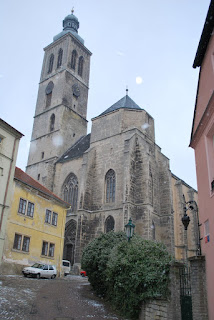Here are some further "after affects" of my trip to Prague. The city is so intriguing and I have taken so many pictures that I can't help continuing to share them. However, you may be starting to feel that this is like getting invited over to someone's house to see pictures of their trip and they never know when to stop...

This is the Astronomical Clock located on the side of the Town Hall tower. Every hour the two doors on top open up and the Apostles shuffle by. To mark every hour, the skeleton below rings a bell. The story goes that Master Hunus built the clock in 1490 and was then blinded with a red-hot poker by the town councillors to make sure he couldn't make another clock for someone else. In retaliation, he groped his way around the clock and succeeded in stopping it, but then promptly died of a heart attack. The clock stayed broken for 80 years. I guess time stood still!

I'm not sure that I would have wanted to be involved in municipal politics in Prague during the Middle Ages. These two buildings were part of City Hall and the Czechs had an interesting practice of removing the mayor from office. Several times, city leaders where thrown from these top windows to the pavement below. Getting kicked out of office was taken very literally.

This is one of the most beautiful Gothic churches in Prague. The Tyn Church is boxed in by the houses around it, which are built right against its walls.

The former Jewish ghetto of Josefov is very close to the town square. There are six very unique synagogues and a Holocaust memorial with over 80,000 names covering every bit of wall space. The synagogue below was built in 1530 and is beside the Old Jewish Cemetery, which was in use from 1439 until 1787. There are an estimated 100,000 people buried in the cemetery, sometimes 12 layers deep.


The Estates Theatre can be found on the other side of the Town Square. It is in this theatre that Mozart premiered Don Giavonni. Sherry and I had the privilege of seeing this opera in this theatre.












 We had lunch in what felt like a Medieval Czech restaurant. Four of us shared a wooden bowl filled with saddle of wild boar, deer meatloaf, sausage, mushroom stuffing, roasted potatoes, potatoe pancakes, and gingerbread dumplings with cranberries.
We had lunch in what felt like a Medieval Czech restaurant. Four of us shared a wooden bowl filled with saddle of wild boar, deer meatloaf, sausage, mushroom stuffing, roasted potatoes, potatoe pancakes, and gingerbread dumplings with cranberries.


 And the most amazing cat walk I've seen, complete with a second story entrance!
And the most amazing cat walk I've seen, complete with a second story entrance!

 The vaulted ceilings give a profound sense of the transcendence of God.
The vaulted ceilings give a profound sense of the transcendence of God.
 I really like stained glass windows. I took a picture of every one...just because I could.
I really like stained glass windows. I took a picture of every one...just because I could.
 This is the pulpit for all those "aspiring" preachers!
This is the pulpit for all those "aspiring" preachers! Behind the altar was the most amazing tree.
Behind the altar was the most amazing tree. And of course, the organ.
And of course, the organ.




























